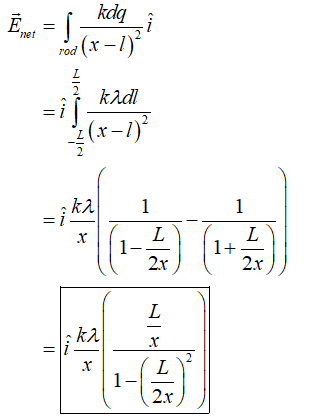Consider an infinitely thin charged rod of length L with uniform linear charge density å lying along the x-axis. The ends are at x = +L/2 and the center is at the origin. a. Calculate the electric field (magnitude and direction) for x > L/2. b. Calculate the force on a test particle with charge qo < 0 located at some position x> L/2. c. Show that the force on the test particle will simplify to Coulomb’s Law when it is sufficiently far away from the rod, i.e. when x >> L. Use Q= AL for the total charge on the rod.
Consider an infinitely thin charged rod of length L with uniform linear charge density å lying along the x-axis. The ends are at x = +L/2 and the center is at the origin. a. Calculate the electric field (magnitude and direction) for x > L/2. b. Calculate the force on a test particle with charge qo < 0 located at some position x> L/2. c. Show that the force on the test particle will simplify to Coulomb’s Law when it is sufficiently far away from the rod, i.e. when x >> L. Use Q= AL for the total charge on the rod.
College Physics
11th Edition
ISBN:9781305952300
Author:Raymond A. Serway, Chris Vuille
Publisher:Raymond A. Serway, Chris Vuille
Chapter1: Units, Trigonometry. And Vectors
Section: Chapter Questions
Problem 1CQ: Estimate the order of magnitude of the length, in meters, of each of the following; (a) a mouse, (b)...
Related questions
Question

Transcribed Image Text:Consider an infinitely thin charged rod of length L with uniform linear charge
density å lying along the x-axis. The ends are at x =±L/2 and the center is at the
origin.
a. Calculate the electric field (magnitude and direction) for x> L/2.
b. Calculate the force on a test particle with charge qo< 0 located at some
position x> L/2.
c. Show that the force on the test particle will simplify to Coulomb's Law
when it is sufficiently far away from the rod, i.e. when x >> L. Use Q=
AL for the total charge on the rod.
Expert Solution
Step 1
Part a:
The net electric field can be obtained by integrating over small fields due to charge dq on a line element dl at a distance l from the origin.

Trending now
This is a popular solution!
Step by step
Solved in 3 steps with 3 images

Knowledge Booster
Learn more about
Need a deep-dive on the concept behind this application? Look no further. Learn more about this topic, physics and related others by exploring similar questions and additional content below.Recommended textbooks for you

College Physics
Physics
ISBN:
9781305952300
Author:
Raymond A. Serway, Chris Vuille
Publisher:
Cengage Learning

University Physics (14th Edition)
Physics
ISBN:
9780133969290
Author:
Hugh D. Young, Roger A. Freedman
Publisher:
PEARSON

Introduction To Quantum Mechanics
Physics
ISBN:
9781107189638
Author:
Griffiths, David J., Schroeter, Darrell F.
Publisher:
Cambridge University Press

College Physics
Physics
ISBN:
9781305952300
Author:
Raymond A. Serway, Chris Vuille
Publisher:
Cengage Learning

University Physics (14th Edition)
Physics
ISBN:
9780133969290
Author:
Hugh D. Young, Roger A. Freedman
Publisher:
PEARSON

Introduction To Quantum Mechanics
Physics
ISBN:
9781107189638
Author:
Griffiths, David J., Schroeter, Darrell F.
Publisher:
Cambridge University Press

Physics for Scientists and Engineers
Physics
ISBN:
9781337553278
Author:
Raymond A. Serway, John W. Jewett
Publisher:
Cengage Learning

Lecture- Tutorials for Introductory Astronomy
Physics
ISBN:
9780321820464
Author:
Edward E. Prather, Tim P. Slater, Jeff P. Adams, Gina Brissenden
Publisher:
Addison-Wesley

College Physics: A Strategic Approach (4th Editio…
Physics
ISBN:
9780134609034
Author:
Randall D. Knight (Professor Emeritus), Brian Jones, Stuart Field
Publisher:
PEARSON